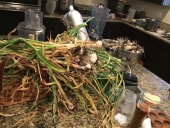

 14
14





QuickBooks set up and Bookkeeping for Small Businesses and Farms - jocelyncampbell.com
 5
5










 3
3




S. Bard wrote:Giardinieras are so delicious and your recipe for it looks great! Lactofermented giardiniera is my favourite method of prepping them as well.
One thing I’d add to your recipe if you want to simplify it further: there’s usually no need to add a starter to a mix of veggies like these. There are already plenty of the necessary bacteria living on the skin of the veggies and your hands (which transfers on the veggies when handling them). Just make sure there’s no chlorine in the water that you’re using for the brine. Of course no harm in kickstarting them if you have a starter at home anyway. But for those who don’t, just know that it is also possible without, it just might take a tad longer. But you have to wait a while anyway for all those delicious flavours to develop :-)
QuickBooks set up and Bookkeeping for Small Businesses and Farms - jocelyncampbell.com
 6
6




 6
6










 5
5




S. Bard wrote:Boiling indeed helps with the chlorine. I usually just fill a big pot of water and leave it uncovered overnight though (maybe a cheesecloth on top if you have flies in the house). The chlorine evaporates overnight.
Paul Houtz wrote:I do a lot of lacto fermenting, mainly cucumbers but also veggies. I just want to remind folks that it is critical to add sufficient salt to your recipe. Don't attempt to reduce salt for dietary reasons. My minimum is 4 tablespoons of salt in 4 cups of distilled water, but lately I have been upping the salt a bit to 4.5 tablespoons. The symptoms of too little salt are: 1. Lots of white mold; 2) slimy cucumbers and other veggies; and 3) somewhat peculiar odor or flavor.
QuickBooks set up and Bookkeeping for Small Businesses and Farms - jocelyncampbell.com
 4
4




Visit Redhawk's soil series: https://permies.com/wiki/redhawk-soil
How permies.com works: https://permies.com/wiki/34193/permies-works-links-threads
 3
3




I'm only 65! That's not to old to learn to be a permie, right?
 2
2




Jay Angler wrote:I have a brined meat recipe that I adore, but also found it way too salty. There was no way I was going to risk reducing the salt content during the "submerge in brine and leave for a week" period, but when it's done brining and I'm ready to slow cook it (think corned beef, but using Muscovy duck legs), I take out the amount I want to cook and soak it in water for an hour. I dump that water for fresh water and then start the slow cooker.
Bonnie, start with this link for the recipe and follow it down a few more posts for more info:
https://permies.com/t/1985/kitchen/recipes-salted-cured-duck#846116
 2
2




 3
3




I grow my own garlic, but in my climate it still doesn't keep reliably past January. Sometime when I have my oven on for other reasons, I bake a bunch of it just in a little water in a covered casserole dish. I peel it and freeze it. I love using baked garlic in things like pesto and hummus, as it seems that my stomach doesn't tolerate raw garlic anymore. It would be interesting to try it on lacto-fermented garlic to see if it makes a difference.Bonnie Kuhlman wrote:One ferment I've just started adding recently is fermented garlic. With no grocery stores nearby, I need to buy a quantity of garlic to last for awhile (I'll grow it next year). It often doesn't keep until the next grocery trip. So, I decided to just ferment a couple of jars full and keep in the fridge to use as needed. So far, I love it. It keeps well, and is peeled and ready to use, but SO much better than the ready-peeled you buy at the store.
Visit Redhawk's soil series: https://permies.com/wiki/redhawk-soil
How permies.com works: https://permies.com/wiki/34193/permies-works-links-threads
 2
2




Bonnie Kuhlman wrote:One ferment I've just started adding recently is fermented garlic. With no grocery stores nearby, I need to buy a quantity of garlic to last for awhile (I'll grow it next year). It often doesn't keep until the next grocery trip. So, I decided to just ferment a couple of jars full and keep in the fridge to use as needed. So far, I love it. It keeps well, and is peeled and ready to use, but SO much better than the ready-peeled you buy at the store.
Weeds are just plants with enough surplus will to live to withstand normal levels of gardening!--Alexandra Petri

|
This tiny ad is guaranteed to be gluten free.
The new permaculture playing cards kickstarter is now live!
https://www.kickstarter.com/projects/paulwheaton/garden-cards
|







